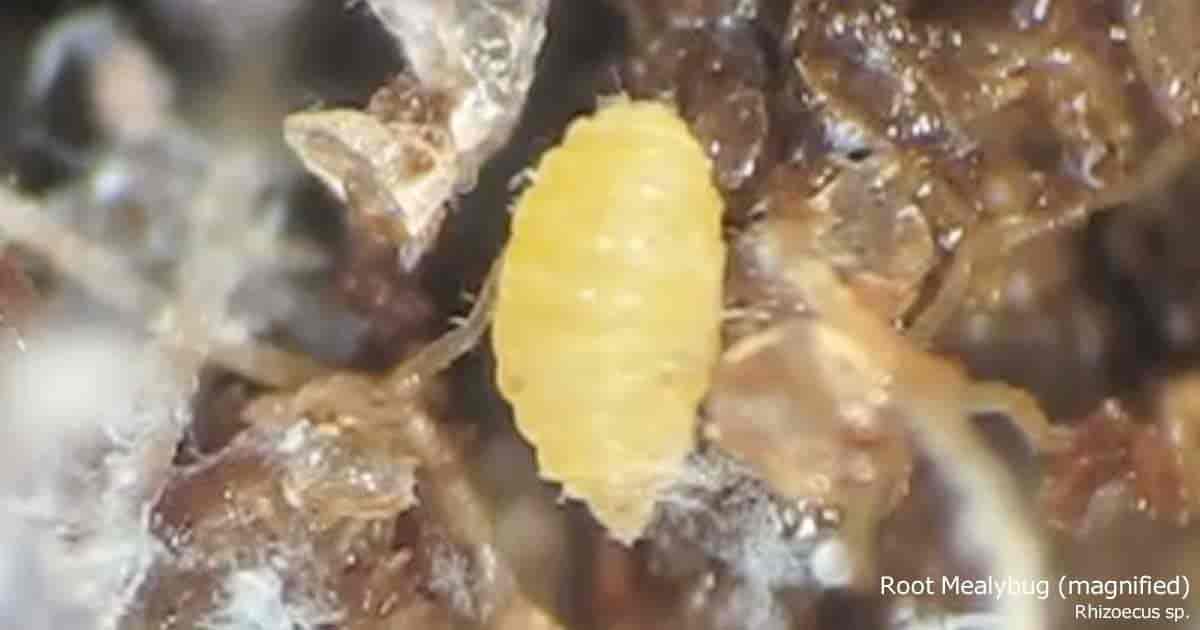At present, there are over 200 species of root mealybugs across the United States.

But, What Are Root Mealybugs?
Root mealybugs (Rhizoecus spp.) are small, wingless insects around one-tenth of an inch long characterized by a thin white or gray wax coating over their bodies. They are slightly larger than fungus gnats.
This unique appearance comes from the waxy coating they secrete when they feed off plants. Smaller bugs are wax-free and tinted yellow.

Root mealybugs are considered pests because of their tendency to feed off the plants’ root system of healthy ornamental plants and trees and act as a catalyst for other plant diseases.
These small insect pests are found worldwide but more often in places with warmer environments.
Soil mealybugs enjoy living in the root ball and potting soil while feeding in moist, warm climates and are found in:
- Succulent Plants – many types
- African Violets
- Zonal Geraniums
- Pelargoniums
- Streptocarpus
Succulent plants and African violets are often watered from below through the drainage holes.
What Damage Does A Root Mealybug Infestation Cause?
Root mealybugs feed on plant roots of host plants by sucking the sap from the tissues through their stylets (or mouth).
As these serious pests feed, they leave behind honeydew, which can later grow mold on the plant.
In smaller numbers, they do not have a significant effect on the plant’s health.

However, their ability to lay eggs and multiply at an exponentially fast rate means they can go from being a mild problem to becoming a heavy infestation in no time.
If the colony of infested plants gets too large, the plants are likely to die from rot.
There are a few ways to identify a mealy bug infestation.
The first signs may be the yellowing and wilting of the leaves, as it will look like the plant’s health begins to deteriorate.
The soil around the plant is also another indicator. The waxy filaments covering the mealy bugs’ bodies may start to take on a blue-tinted appearance.
It can be hard to detect an infestation until the plant is heavily infected.
Look for the bugs while the soil is dry, as watering the area tends to disperse and make it difficult to see.
Related: Controlling Mealybugs On Cactus
How To Control Root Mealybugs
There are several ways to treat soil mealy bugs if your plants have been affected.
- Natural pest control
- Biological control
- Organic pest options
- Chemical control

Natural Pest Management
NOTE: Years ago, I knew a private succulent grower (Reggie) in South Florida.
He handled root mealybug populations on his succulents with hot water dips. He submerged the roots in hot water. Here was his process.
For potted plants, Reggie would get rid of the ground mealybug infestation by:
- Removing the infected succulent plant from its pot
- Knocking off and removing as much soil as possible
- Sterilize the plant and root system by soaking the roots in hot water to increase the root ball temperature between 115° to 120° degrees Fahrenheit for about 10 minutes.
- Sterilize or replace the pot
- This effectively killed the mealy bugs and their eggs living inside the roots without harming your plant.
- Reggie would then repot the succulent into fresh soil.
- He also mixed a little bit of diatomaceous earth into the potting mix to help control mealies or eggs that escaped.
Biological Control Of Root Mealies
The mealybug destroyer (Cryptolaemus montrouzieri) are small gray beetles often used to control citrus mealybugs (Planococcus citri).
Both adults and larvae feed on mealybugs. The larval stage resembles a mealybug.

Before releasing these mealy destroyers, DO NOT use any insecticides or pesticides for at least a month before their release.
Related: What To Do About Tiny White Bugs In Soil
Organic Insect Management Options
Neem oil, insecticidal soaps, and diatomaceous earth are all organic options available to control mealybug populations.
As mentioned above, diatomaceous earth can be mixed into the soil.

Insecticidal soaps and Neem oil can be used as a drench on some plant varieties. Neem drench works as a systemic insecticide as well.
Hydrogen peroxide is used to control fungus gnats, and it has also been recommended for root mealybugs. But I have not tried it.
Chemical Controls
It can be trickier to deal with root mealybug control in soil on plants in your garden.
A pesticide is your best option in such a scenario.
Some pesticides you can use include Phenothrin, Bifenthrin, Chlorpyrifos, Dichlorvos, and Tetramethrin.

To prevent further infestations, take some precautionary measures.
This includes being careful about any new plants you intend to buy.
Make sure they are free of any clear signs of infections
Wash out affected pots with soap and hot water to ensure any plant repotted does not catch the bugs.
Avoid letting water from an infected plant or infested areas travel to other plants.
Baby root mealybugs can be transported through the water and infect other plants.
If possible, avoid root-bound plants as they are likely to develop host colonies of root mealy bugs.